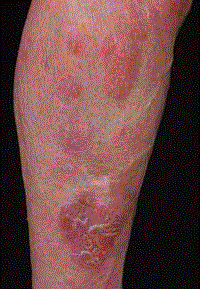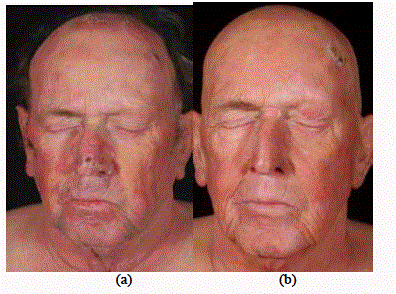Case Report
Total Body Electron-Radiation Therapy in Mycosis Fungoides: A Case Report
Schultze J1*, Siebert FA1 and Galalae R2
1Department of Radiation Oncology, University Medical Center Schleswig-Holstein, Germany
2Evangelic Hospitals Gelsenkirchen, Germany
*Corresponding author: Jürgen Schultze, Department of Radiation Oncology, University Medical Center Schleswig-Holstein, Campus Kiel, Arnold-Heller-Strasse 3, Hs.50, D-24105 Kiel, Germany
Published: 14 Oct, 2017
Cite this article as: Schultze J, Siebert FA, Galalae R. Total
Body Electron-Radiation Therapy in
Mycosis Fungoides: A Case Report.
Ann Clin Case Rep. 2017; 2: 1449.
Abstract
A cutaneous T-cell-Lymphoma was progressive after six different lines of chemotherapy. For local palliation total body electron-radiation therapy was performed with a total dose of 27, 5 Gy at single doses of 1,5 Gy and 1 Gy respectively. The treatment resulted in complete remission lasting for 19 months until a cardiac related death. Therefore radiation therapy should be offered earlier in the entire treatment course in order to achieve lasting local control.
Introduction
Mycosis fungoides is predominantly treated by a combination of cytotoxic, systemic therapy
with immunotherapy and photochemotherapy (PUVA). Radiation therapy as a mean of treatment
therefore does not play anymore a decisive role in the treatment of cutaneous Non-Hodgkin-
Lymphoma. Actually radiation therapy is mainly applied to achieve lasting local control of residual
lymphoma manifestations. Therefore the knowledge has declined for the role that radiotherapy can
play in cases where systemic therapies have not been proven effective.
Hence we would like to present a case of mycosis fungoides progressive after unsuccessful sixthline
systemic therapy where total body electron therapy has been performed.
Case Presentation
In 1997, in a then 52 years old male patient a cutaneous T-cell-Lymphoma stage II B had been
diagnosed. In September 2006, the patients presented with an acute exacerbation of his cutaneous
lymphoma.
Until April 2010 numerous systemic therapies were performed: Psoralen orally plus UV-A
therapy, liposomal doxorubicin, PUVA-therapy in combination with interferon, therapy with
Vorinostat, methotrexate over 3 months, 8 cycles of gemcitabine and again PUVA-therapy with
Geralen and interferon [1-4].
Because local radiation therapy in March 2008 supraorbitally on the left side had produced a
complete and lasting remission the patient presented again in the department of radiation oncology
with the question whether radiological means of treatment could be applied in his now therapyresistant
status (Figure 1).
Figure 1
Figure 2
Figure 2
(a) Facial involvement except left periorbital region after prior
radiation therapy. (b) Nearly complete remission 6 weeks after radiotherapy.
Discussion
Due to the unsuccessful prior therapies and increasing complaints of the patient radiation
therapy was indicated as an attempt to reach palliation. The radiotherapy was performed as wholebody
electron therapy with shielding of a prior implanted defibrillator, both eyes and all finger and
foot nails. Treatment was done from July to September 2010 in the modified Stanford-technique
with single doses of 1,5 Gy up to a total dose of 16,5 Gy.
After an interruption of 17 days due to a cardiac event treatment was continued with single
doses of 1 Gy up to a cumulative, total dose of 27,5 Gy in the entire integument. Acute side effects
of radiotherapy were pigmentation and erythema according RTOG grade III, alopezia of the scalp
and mild weakness.
Concerning the lymphoma manifestation a nearly complete remission was to notify except in
the shielded areas. The patient himself rated his general status according ECOG 0 and was nearly
free of any complaints. 19 months after completion of therapy the patient died due to cardiac event in lasting, complete remission of his cutaneous lymphoma (Figure 2a and b).
Conclusion
Whole-body electron radiation therapy proved to be a highly effective mean of treatment in chemotherapy resistant cutaneous Non-Hodgkin-Lymphoma. Acute toxicity is manageable without problems. Radiotherapy should be considered earlier in the treatment process, preferable after 3rd line chemotherapy. Radiotherapy should be actively promoted and offered to our fellow colleagues in dermatology.
References
- Hagedorn M, Hasche E, Kober B, Sander CA. Long term results of total skin electron beam therapy (TSEBT) in the treatment of mycosis fungoides. Hautarzt. 2003; 54: 256-264.
- Hess CF, Schmidtberger H, Weiss. Radiation therapy in Non-Hodgkin-lymphoma. Onkologe. 1997; 3: 539-547.
- Hoppe RT, Cox RS, Fuks Z, Price NM, Bagshaw MA, Farber EM. Electron-beam therapy for mycosis fungoides: the Stanford University experience. Cancer Treat Rep. 1979; 63: 691-700.
- Götting N, Siebert FA, Schultze J. Physikalisch-technische Vorbereitung und Durchführung einer Ganzhaut-Elektronentherapie. Strahlenther Onkol. 2011; 187; 1:108.


